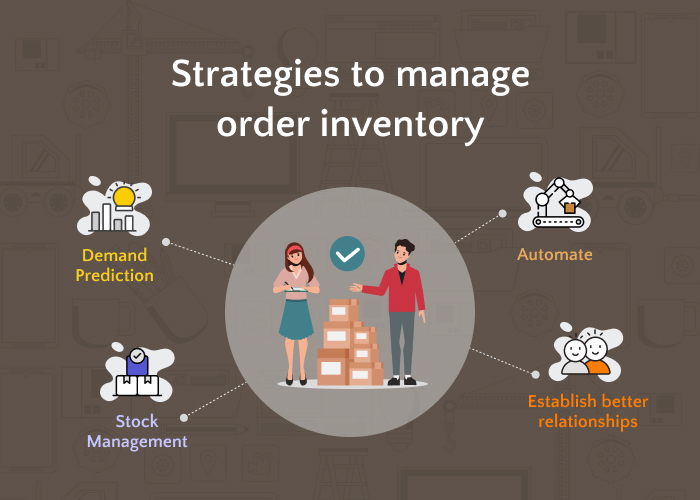Strategies to manage order inventory

- Demand Prediction: Examine and audit the prior sales, including product demand, high and low-demand items, products that can generate the highest profit, market trends, consumer behavior, and, if applicable, the point at which your inventory ran out during the previous sale. Data analytics tools and surveys are useful for identifying market trends and predicting shifts in consumer behavior.
- Stock Management: Maintain the ideal balance between decreasing surplus stock that uses up resources and money and having enough inventory to fulfill demand. High-demand products must be given priority when it comes to inventory and fulfillment, and enough stock levels must be maintained for these items. In order to draw in more customers and manage order, think about providing bundles or unique-themed goods.
- Automate: Workflow automation speeds up and simplifies the inventory process. Stock management and inventory level are taken care of by automated inventory management while the staff is out responding to many “add-to-cart” messages. Automation might, for instance, delete an out-of-stock product from the catalog or, in accordance with predetermined guidelines, send reminders.
- Establish better relationships: Select dependable and trustworthy vendors. Develop a stronger rapport with them in order to obtain on-time delivery and agreeable conditions, guaranteeing a stable supply chain during the busy holiday season. It’s also important to remember that your supplier will be just as busy as you are and that high-demand items over the peak season can result in a backlog. To prevent this, place and confirm your purchase well in advance, ideally before the deals start, and remember to factor in your lead time.
Strategies to manage order fulfillment
- Simplify the process: Sorting and organizing your warehouse is the first step towards streamlining your processes because there will be a surge in merchandise during sales. In a more structured setting, managing large order volumes and inventories is simpler. Furthermore, think about using solutions that automate repetitive processes to manage order and label creation to save time.
- Shipping Process: It’s crucial to provide as many delivery alternatives as you can and to carefully consider your shipping options. For companies, free delivery is an essential marketing strategy; nevertheless, free shipping isn’t always free. It has a price and is frequently quite expensive. Carefully consider your options before providing free delivery for your customers. You must establish your free shipping minimum threshold in order for free delivery to benefit you.
- Returns: Online sellers will undoubtedly receive some returns. Make your return policy available to visitors of your online store when you accept returns. 60% of consumers carefully read the return policy before making an online purchase. Thus, make the most of your return policy to grow your store’s customer base, and work tirelessly to ensure that returns are handled efficiently.
Conclusion
To manage order fulfillment and inventory, stock levels, product variances, and restocking requirements should all be monitored with management software. Make use of an integrated system that links inventory control and order processing. Collaborate with trustable vendors to guarantee a consistent and punctual supply of merchandise. Furthermore, during the checkout process, express shipping prices and times in a clear manner. Thereafter, analyze order fulfillment parameters on a regular basis, such as accuracy and processing time. Put in place a tracking system that lets you and your customers keep an eye on the status of orders in real-time.
FAQs
How often should I update my inventory records?
Can I use multiple suppliers for the same product?
What is the benefit of outsourcing fulfillment?
How can I handle returns efficiently?
What is the role of order processing systems in e-commerce?
Ravi Bhojani is the Chief Marketing Officer (CMO) at Alian Software, where he spearheads the company’s marketing strategies and drives its brand presence in the competitive IT services landscape. With over a decade of experience in the technology and marketing sectors, Ravi has consistently demonstrated his ability to blend innovative marketing techniques with deep industry knowledge to deliver outstanding results.